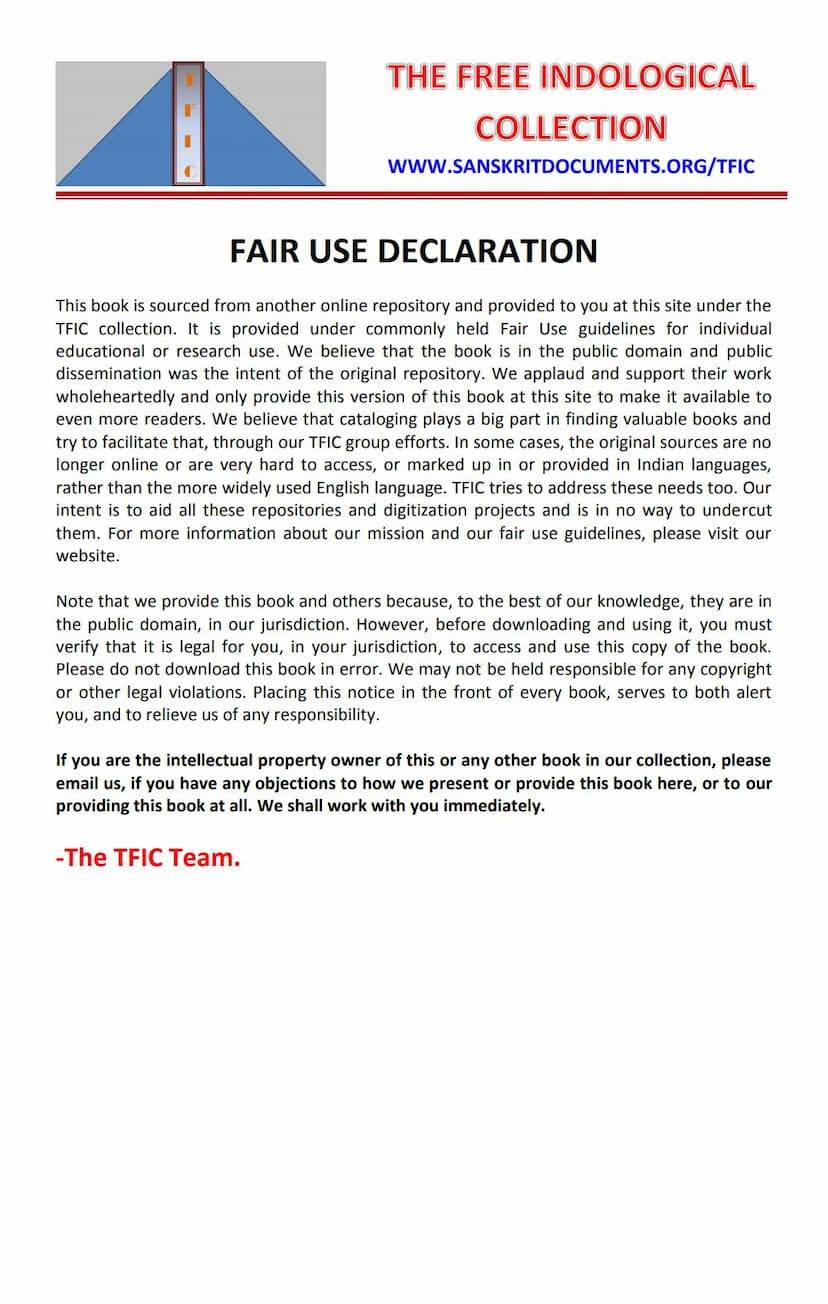Jain Kumar Sambhavakhyam
Added to library: September 2, 2025

Summary
The Jain text "Jain Kumar Sambhavakhyam" by Jayshekharsuri, published by Acharyarakshit Pustakoddhar Sanstha, is a significant Jain Mahakavya (epic poem). Here's a comprehensive summary based on the provided information:
1. Title and Author:
- Title: Jain Kumar Sambhavakhyam (Shri Jain Kumara Sambhava Akhyam Mahakavyam)
- Author: Pujya Acharya Shrimad Jayshekharsuri (Pujya Acharya Shrimad Jayshekharsuri)
- Dedication: The work is dedicated to Lord Jin (Shri Jinay Namah), Shri Gautamswami Guru, and Acharya Rakshit Guru.
2. Publisher and Publication:
- Publisher: Jamnagar Shri Acharyarakshit Pustakoddhar Sanstha (Jamnagar Shri Acharya Rakshit Pustakoddhar Sanstha)
- Printer: Jamnagar Shri Jain Bhaskaroday Mudranalaye Jesanglal Hiralal (Jamnagar Shri Jain Bhaskaroday Mudranalaye Jesanglal Hiralal)
- Price: 4-0-0 (likely in old currency)
3. Literary Significance and Context:
- Nature of the Work: Described as an "extraordinary," "poetically miraculous," and "rich in literary rasa" काव्य (kavya - poem).
- Inspiration: It is compared to Kalidasa's "Kumarasambhava," with the author Jayshekharsuri composing "Jain Kumar Sambhava" to render a similar literary service to Jain literature.
- Author's Background: Pujya Acharya Shrimad Jayshekharsuri was a disciple of Bhattarak Shri Mahendra Prabhasuri of the Anchalgachha. His literary contributions are described as "unparalleled," with other notable works including "Upadesh Chintamani," "Prabodh Chintamani," and "Dhamil Charitra," all showcasing his exceptional poetic skill and vast scholarship.
- Time Period: Acharya Jayshekharsuri was active in Vikram Samvat 1436.
- Divine Inspiration: The text mentions that Goddess Saraswati had blessed him, as indicated by phrases like "Vanidatta Varashiram."
4. Content and Structure:
- Subject Matter: The epic primarily narrates the life and deeds of Rishabhdev, the first Tirthankara, and his elder son Bharat Kumar.
- Key Themes:
- Narrative of Rishabhdev and Bharat: The core of the epic revolves around their lives, likely encompassing their ascents to power, their spiritual journeys, and their contributions to the world. L Laukika Vivaha Vidhi: The poem also details the traditional worldly marriage rituals, offering valuable insights into the social customs prevalent during the author's time. This act is seen as a great service to the readers.
- Structure: The text mentions the work is adorned with eleven sections (अगीयार साँथी).
- Tika (Commentary): The book includes a commentary (टीकासहितं) of approximately 800 verses, believed to have been written by Jayshekharsuri himself. This commentary is crucial for deeper understanding, as it elaborates on the original verses and sometimes clarifies them with references to the grammar of Siddha Hem, further enhancing clarity.
5. Discovery and Publication History:
- Initial Publication: The first publication of the work, containing the original verses and a Gujarati translation, was made by Shravak Bhimsi Manek in Samvat 1957, facilitated by Pandit Hiralal Hansraj of Jamnagar.
- Discovery of Commentary: While researching, it was discovered that Jayshekharsuri himself had written a commentary of about 800 verses on the work. However, copies of this commentary were not readily available.
- Availability of Commentary: A copy was eventually obtained through the Anandpur Library in Surat. This copy was then transcribed by Pandit Manishankar Chhaganlal, who also added grammatical explanations, particularly referencing Siddha Hem's grammar.
- Efforts for Publication: The publication of this refined edition was significantly aided by Pujya Panneasji Maharaj Shri Dansagarji Maharaj and his disciple Nem Sagarji Maharaj, who made continuous efforts to bring it to light.
6. Errata/Correction Sheet (शुद्धिपत्रकम्):
- The included "Shuddhipatrakam" (errata list) is extensive, indicating numerous corrections made during the printing process. This spans pages 7 to 16, detailing a vast number of textual inaccuracies in the original printing and their corresponding corrections, ranging from single letters and words to grammatical inflections and references. This highlights the meticulous effort involved in preparing this edition.
7. Fair Use Declaration:
- The collection is from "The Free Indological Collection" (TFIC) of www.sanskritdocuments.org.
- The book is provided under Fair Use guidelines for individual educational or research purposes.
- The TFIC team believes the book is in the public domain and that public dissemination was the intent of the original repository.
- Their mission is to make valuable books accessible, especially those that may be out of print, hard to access, or only available in Indian languages.
In essence, "Jain Kumar Sambhavakhyam" is a venerated Jain epic that celebrates the lives of Lord Rishabhdev and Bharat Kumar. Its significance lies not only in its religious and historical narrative but also in its rich literary quality, detailed descriptions of ancient customs, and the valuable commentary that enhances its accessibility and understanding for future generations.